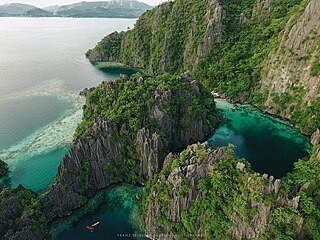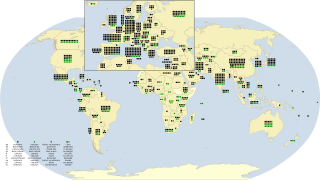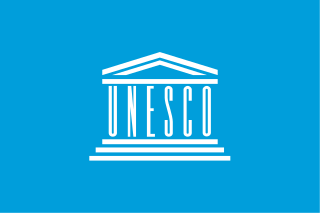Related Research Articles

A World Heritage Site is a landmark or area with legal protection by an international convention administered by the United Nations Educational, Scientific and Cultural Organization (UNESCO). World Heritage Sites are designated by UNESCO for having cultural, historical, scientific or other forms of significance. The sites are judged to contain "cultural and natural heritage around the world considered to be of outstanding value to humanity".

Cultural landscape is a term used in the fields of geography, ecology, and heritage studies, to describe a symbiosis of human activity and environment. As defined by the World Heritage Committee, it is the "cultural properties [that] represent the combined works of nature and of man" and falls into three main categories:
- "a landscape designed and created intentionally by man"
- an "organically evolved landscape" which may be a "relict landscape" or a "continuing landscape"
- an "associative cultural landscape" which may be valued because of the "religious, artistic or cultural associations of the natural element."

UNESCO's Memory of the World (MoW) Programme is an international initiative launched to safeguard the documentary heritage of humanity against collective amnesia, neglect, decay over time and climatic conditions, as well as deliberate destruction. It calls for the preservation of valuable archival holdings, library collections, and private individual compendia all over the world for posterity, the reconstitution of dispersed or displaced documentary heritage, and increased accessibility to, and dissemination of, these items.

Tourism is an important sector for Philippine economy. The travel and tourism industry contributed 6.2%% to the country's GDP in 2022; this was lower than the 12.7% recorded in 2019 prior to the COVID-19 lockdowns. The country is known for having its rich biodiversity as its main tourist attraction. Popular destinations among tourists include Boracay, Palawan, and Siargao. Despite potential, the Philippines has lagged in tourism industry behind some of its Southeast Asian neighbors due to political and social problems.

East Rennell is the southern portion of Rennell Island in the Solomon Islands which is designated a UNESCO World Heritage Site. Rennell is the largest raised coral atoll in the world and the area in East Rennell surrounding Lake Tegano contains many endemic species.

As of January 2023, there are a total of 1,157 World Heritage Sites located across 167 countries, of which 900 are cultural, 218 are natural and 39 are mixed properties. The countries have been divided by the World Heritage Committee into five geographic zones: Africa, Arab States, Asia and the Pacific, Europe and North America, and Latin America and the Caribbean. With 58 selected areas, Italy is the country with the most sites on the list.

The Historic Centre of Macao is a collection of over twenty locations that witness the unique assimilation and co-existence of Chinese and Portuguese cultures in Macau, a former Portuguese colony. It represents the architectural legacies of the city's cultural heritage, including monuments such as urban squares, streetscapes, churches and temples.
Australia ICOMOS is a peak cultural heritage conservation body in Australia. It is a branch of the United Nations-sponsored International Council on Monuments and Sites (ICOMOS), a non-government professional organisation promoting expertise in the conservation of place-based cultural heritage. Its secretariat is based at the Cultural Heritage Centre for Asia and the Pacific at Deakin University.

The United Nations Educational, Scientific and Cultural Organization (UNESCO) is a specialized agency of the United Nations (UN) aimed at promoting world peace and security through international cooperation in education, arts, sciences and culture. It has 194 member states and 12 associate members, as well as partners in the non-governmental, intergovernmental and private sector. Headquartered in Paris, France, UNESCO has 53 regional field offices and 199 national commissions that facilitate its global mandate.
UNESCO Asia Pacific Heritage Awards are given with as the strategic purpose of UNESCO with in the region Asia Pacific. The objective is to motivate the protection of Cultural Heritage sites, which are initiated by any individual organization under private sector or institutional organization.

Tai Kwun, or the Former Central Police Station Compound includes three declared monuments in Central, Hong Kong: the former Central Police Station, the Former Central Magistracy, and the Victoria Prison. Surrounded by Hollywood Road, Arbuthnot Road, Chancery Lane and Old Bailey Street, the compound underwent a heritage revitalisation and reopened to the public on 29 May 2018 as "Tai Kwun", a centre for heritage and arts.
Panineman is a traditional open-deck fishing boat of the Ivatan people from the island of Itbayat in the Philippines. It is slightly larger than the largest types of tataya, and can accommodate three pairs of rowers and a single sail.
Tim C. Winter is an Australian sociologist and international relations (IR) scholar, Professor and Senior Research Fellow at Asia Research Institute, National University of Singapore. His research interests revolve around understanding how cultural heritage influences public audiences and features in issues such as urban development, diplomacy, geopolitics, post-conflict recovery, sustainability, postcolonial identities, and nationalism. He has contributed to the conceptual development of heritage diplomacy and introduced geocultural power to the analysis of IR. He was previously an Australian Research Council Professorial Future Fellow, Professor of Critical Heritage Studies (CHS) at the University of Western Australia, and Research Professor in CHS at Cultural Heritage Centre for Asia and the Pacific, Deakin University. He was the Editor of Historic Environment (2006-2015). He is President of the Association of Critical Heritage Studies.
References
- ↑ "Welcome to the Cultural Heritage Centre for Asia and the Pacific". Deakin. Retrieved 19 July 2014.
- ↑ "Cultural Heritage Centre for Asia and the Pacific". Archived from the original on 2008-08-03.